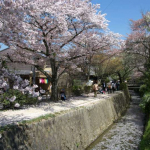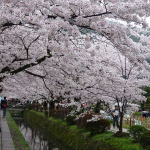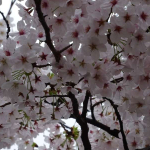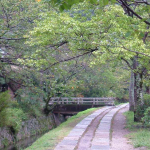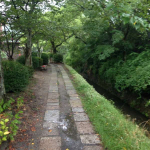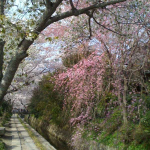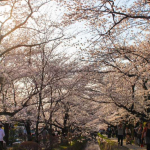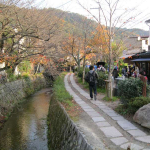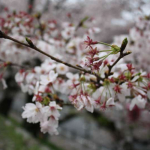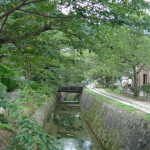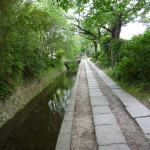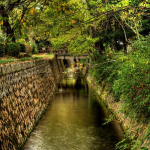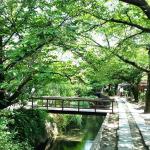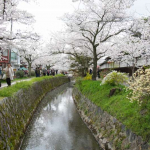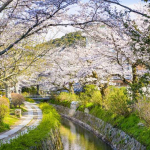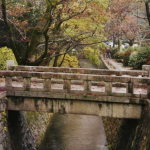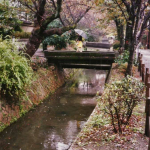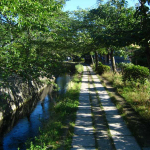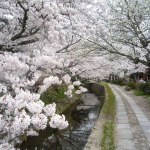Philosopher’s Path
People are people,
and I will be myself.
Regardless,
the path I follow
I will follow on…
–Nishida Kitaro
Red: Places of Interest Blue: Eat Green: Sleep
The Path of Philosophy, or Tetsugaku-no-michi in Japanese, is a beautiful canal-side strolling path in northern Higashiyama, that runs between Ginkaku-ji Temple in the north and Eikan-do Temple in the south. It is named after a philosophy professor at Kyoto University, Nishida Kitaro, who when tired of grappling with complex problems about the nature of reality and man’s place in the universe, would refresh himself with a brisk constitutional walk among Kyoto’s most scenic spots. Though the Path is most famous for its cherry blossoms in the spring, and its colorful foliage in the fall, in any season you will find much to reward the eye, and many sites of interest along the way.
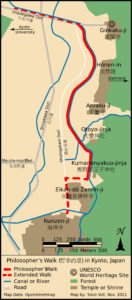 The Path of Philosophy can be approached from the north or the south. Spending a little time Eikan-do Temple at the south before joining the Path proper, is perfect for putting you in the right frame of mind for philosophical walking.
The Path of Philosophy can be approached from the north or the south. Spending a little time Eikan-do Temple at the south before joining the Path proper, is perfect for putting you in the right frame of mind for philosophical walking.
Built on a wooded hillside, this extensive temple complex is most popular in the autumn for its gorgeous display of red and gold maple leaves. In other seasons though, it is a green oasis of calm. An hour or more exploring this beautiful temple complex and its gardens will help you forget the hustle and bustle of the world outside and set your mind at peace.
This temple was first built in 856 and originally named Zenrin-ji. The later name Eikan-do was chosen to honor the 7th abbot Eikan (also known as Yokan). Eikan was famous for helping the poor and sick. He restored much of the temple complex and he built a hospital on the temple grounds. He was also famous for his devotion to Amida Buddha, an incarnation of the Buddha who has vowed to save all living things. In the Amida Hall of Eikan-do you can see a very famous statue of Amida Buddha called the “Mikaeri Amida” or “Looking Back Amida”. The statue is unusual because the face is turned to the side and appears to be looking over its shoulder. This symbolically suggests that the Buddha is asking us to follow him.
According to legend however, when Eikan first brought this statue from Nara it simply faced forward. One winter morning in 1082 when Eikan and his disciples were walking around the statue chanting the Buddha’s name, the statue suddenly came to life, got down off its pedestal and began to lead them. Taken aback by this miracle Eikan and his disciples naturally stopped in their tracks with their mouths open. Noticing the sudden silence, the statue then turned round and told them to hurry and catch up! And that is why the statue has been looking back ever since.
Head north from Eikan-do and take a right. You will find the canal here and Nyakuoji-jinja: a small shrine with a long history. Retired emperor Go-Shirakawa established Nyakuoji-jinja in 1160 as the guardian shrine for the area and over the centuries many warriors and shoguns visited here to view the cherry blossoms. On the mountain behind the shrine, Nijima Jo, the great 19th century educator and founder of Doshisha University lies buried with his wife Yae. This shrine marks the true beginning of the Path of Philosophy.
Minobusan Kuonji Temple is the head temple of Nichiren Shu, located in Yamanashi Prefecture, Japan. Since its founding in 1274 more than seven centuries ago, it has attracted numerous visitors as a sacred site of the Lotus Sutra.
The spirit and remains of Nichiren Shonin, the founder of the denomination, who passed away in Ikegami in present-day Tokyo in October 1282 are enshrined in this temple, in accordance with his will, that his grave site be built in the Minobusan precincts where he had spent nine years reciting the Lotus Sutra.
http://www.kuonji.jp/english/entop.htm
Nishida Kitaro (1870 – 1945) was born in the late 19th century when Japan was greedily absorbing knowledge and technology from the West. As a young man, Nishida, just as greedily, read widely in both Western philosophy and traditional Eastern thought. Naturally inclined towards contemplative and spiritual pursuits, he devoted his life to creating a unique philosophical system which married Western rationalism and Buddhist insights into the nature of existence. In his own lifetime his books were bestsellers, and his ideas acted as an inspiration for many other great thinkers. His legacy is the philosophical bridge he built between the world’s great cultural traditions. He was, in short, a great man.
By all accounts Nishida was also a keen walker. He would pace up and down his verandah when struggling with particularly difficult ideas, and he would stride up and down the podium when giving his lectures at Kyoto University. When he needed a break from the incessant workings of his brain, he would escape to the hills of Higashiyama for a walk. On such a meditative stroll he is said to have come to his first great insight into the nature of pure experience. When we walk this Path we are following in his footsteps. What insights and experiences will it bring us?
About halfway up the Path, just opposite the Pomme Café, is a memorial stone set into the verge by the side of the canal. Carved into the stone is a short poem by our eponymous philosopher, Nishida Kitaro.
The stone reads:
hito wa hito
ware wa ware nari
tonikaku
waga yuku michi o
waga wa yukunari
People are people,
and I will be myself.
Regardless,
the path I follow
I will follow on…
Nishida wrote this poem in 1934 when Japan was falling increasingly under the sway of right wing nationalist ideology. He disapproved of the nationalists’ short-sighted and aggressive policies and their anti-foreign sentiment. The nationalists also viewed Nishida with suspicion, for his world view was inclusive and he saw Japanese culture, as one part of a greater global culture. Despite his concerns for his country Nishida took a long view. He knew that the bad times would someday pass, and that the legacy of his work would remain. This is his most famous poem and it expresses his stubborn determination to ignore the trends of the time and keep going his own way.
http://japanshrinestemples.blogspot.com/2014/03/otoyo-jinja-kyoto.html
Otoyo-jinja Shrine
Shrine is popular with Japanese who seek health, cure for illness, good fortune, long life and assistance with matchmaking.
Otoyo-jinja is noted for the unusual guardian animals that mark the entrance to one of the inner shrines. It is normal to see guardian dogs or foxes at the entrance to a shrine, but this shrine has mice!
Otoyo-jinja is dedicated to the hero-god, Okuninushi, who had a particularly good relationship with mice. An old story has it that Okuninushi wanted to marry the storm god Susanoo’s daughter, but Susanoo wasn’t so keen on the idea. To get rid of the ardent young suitor he shot an arrow into a field of tall reeds and told Okuninushi to go fetch it. Hoping to please his future father-in-law, Okuninushi dutifully trotted off on his seemingly impossible task. Susanoo then set the field on fire on all sides. Our hero was trapped and seemingly doomed, when he heard a tiny little voice at his feet. It was a mouse, who proceeded to show him a small hole in which to wait out the fire – and when the flames had passed the helpful mouse brought him the arrow too.
Kisaki
Kyoto is famous for its tofu and yuba (tofu skin) cuisine and this is a great place to try this traditional vegetarian fare.
http://www.kyoto-kisaki.com/english.html


